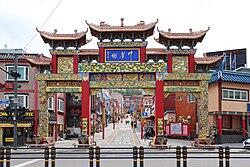| Incheon Chinatown | |
|---|---|
 | |
| Coordinates: 37°28′35″N 126°37′05″E / 37.4763°N 126.6181°E / 37.4763; 126.6181 | |
| Country | South Korea |
| City | Incheon |
| District | Jung |
| First Chinese settlers | 1884 |
| Website | www |
Incheon Chinatown (Korean: 인천차이나타운; Chinese: 仁川唐人街) is a Chinatown in Jung District, Incheon, South Korea. It is the only official Chinatown on the Korean peninsula, and one of the earliest, having formed in 1884. There are a number of restaurants and tourist attractions in the area. It features an 11-meter high Chinese-style gateway, or paifang.
The area is located nearby other attractions such as Jayu Park and Wolmido. There are also Japan-related attractions nearby.
History
The history of Incheon Chinatown is over 100 years old. While not all traditional culture of the first generation has been preserved, the area still harbors many of the flavors of China.
Incheon became a China-friendly city after the modern opening of late 1800s. Korea started modern trade by signing the China–Korea Treaty of 1882. Incheon's Chinatown area came into being with the opening of the Incheon Port in 1883 and Incheon's designation as an extraterritoriality of the Qing dynasty. After this, 'Incheon Chinese Society' (華僑) begun in earnest following the establishment of the Chinese concession of Incheon in today's Incheon in 1884. An 1883 report indicated that 63 Chinese people lived there. And they increased to 235 people in one year. In 1892, they increased to 637 people, and they increased to about 1000 people in early 1900. Overseas Chinese who currently live in Incheon in 2015 number 50,000 people. 'Incheon Chinatown' improved the relationship of Korea and China. Incheon Chinatown street name will change to China's well-known street or city names in 2016. Today, the Chinese residents of Chinatown are mostly 2nd or 3rd generation descendents of the early Chinese settlers.
Attractions

Restaurants in the area serve both more authentic Chinese food, as well as Korean Chinese food. Examples of Korean Chinese food include tangsuyuk and jajangmyeon.
The Jajangmyeon Museum is located in the enclave; it is the former site of the historic c. 1905 – 1983 Chinese restaurant Gonghwachun, which is considered the first restaurant to serve jajangmyeon in Korea. There is another restaurant that opened under the name "Gonghwachun" in 2004 that claims to continue the legacy of the original, but this claim has been disputed by the original restaurant's founding family.
Stores sell China-related goods, such as qipao, Chinese ceramics, Chinese tea, as well as various jewelry and accessories.

Incheon Chinatown has many attractions such the Chinese-style temple Uiseondang (의선당; 義善堂). It also has a street of murals depicting the history of Three Kingdoms. The Korea–China Cultural Center was built in 2005. There is also a Chinese school that was constructed in 1934.
References
- "중구시설관리공단 > 주요사업 > 근대건축전시관". www.icjgss.or.kr. Archived from the original on 2020-04-05. Retrieved 2015-12-07.
- "[인천 가볼만한 곳]차이나타운 한중문화관". 인천시 공식 티스토리 블로그. Archived from the original on 2016-04-05. Retrieved 2015-12-07.
- ^ "[SN여행] 볼거리와 먹을거리가 가득한 인천 속의 중국 '차이나타운' - 지식교양채널 시선뉴스". www.sisunnews.co.kr. Retrieved 2015-12-02.
- "이국적이고 동심이 있는 차이나타운·동화마을 오세요". Yonhap News Agency (in Korean). Retrieved 2015-12-02.
- "인근관광지 > 자유공원 | 인천차이나타운". www.ichinatown.or.kr. Retrieved 2015-12-01.
- "Incheon chinatown".
- "인천 차이나타운 '100년 캡슐' 열렸다 : 뉴스 : 동아닷컴". The Dong-a Ilbo. Retrieved 2015-11-28.
- ^ "Incheon China Town (인천 차이나타운)". english.visitkorea.or.kr. Retrieved 2015-12-07.
- ^ "능허대~차이나타운 '통교'의 역사는 흐른다". 기호일보. Retrieved 2015-11-28.
- "Guide to Incheon's Chinatown". Retrieved September 30, 2023.
- "주간조선 - 1등 인터넷뉴스 조선닷컴". weekly1.chosun.com. Retrieved 2015-11-28.
- "인천 개항누리길 도보여행". 국제신문. Retrieved 2015-11-28.
- "베이징로·난징로…인천 차이나타운에 중국 거리 조성". Yonhap News Agency (in Korean). Retrieved 2015-12-14.
- "먹거리종류 | 인천차이나타운". www.ichinatown.or.kr. Retrieved 2015-11-28.
- "The birth of Jajangmyeon, "Incheon Gonghwachun" -". Seoul Metropolitan Government. 2015-09-16. Retrieved 2024-06-27.
- 강, 신일 (April 27, 2012). "다시 만난 공화춘 역사를 맛보다". Incheon Ilbo. Retrieved 2024-07-03.
- 박, 동휘 (August 7, 2006). "'중국집 원조' 공화춘 자장면 편의점서 맛 보세요". 한국경제 (in Korean). Retrieved 2024-07-03 – via Naver News.
- 장, 혜진. "'제보자들' 100년 전통 공화춘 짜장면을 둘러싼 처절한 원조 싸움". Busan Ilbo (in Korean). Retrieved 2024-07-03.
- "살거리 | 인천차이나타운". www.ichinatown.or.kr. Retrieved 2015-11-28.
- "중국옷". terms.naver.com. Retrieved 2015-11-28.
- "The Chosun Ilbo (English Edition): Daily News from Korea - Incheon's Chinatown a Home from Home for Taiwanese Visitor". The Chosun Ilbo. Retrieved 2015-12-01.
- "한중문화관 관광축제 - 2015 문화를 관광하다". Aju Business Daily (in Korean). Retrieved 2015-12-01.
- "가톨릭 신문 신문기사 보기". www.catholictimes.org. Retrieved 2015-12-01.
Further reading
- Yi Jung-hee. A Country Without a Chinatown, Joseon Ilbo, 2000
- Yang Phil-seoung. 2004. A country without a Chinatown: Yesterday and Today in the Overseas Chinese Economy of Korea
| Chinatowns in Asia | |
|---|---|
|